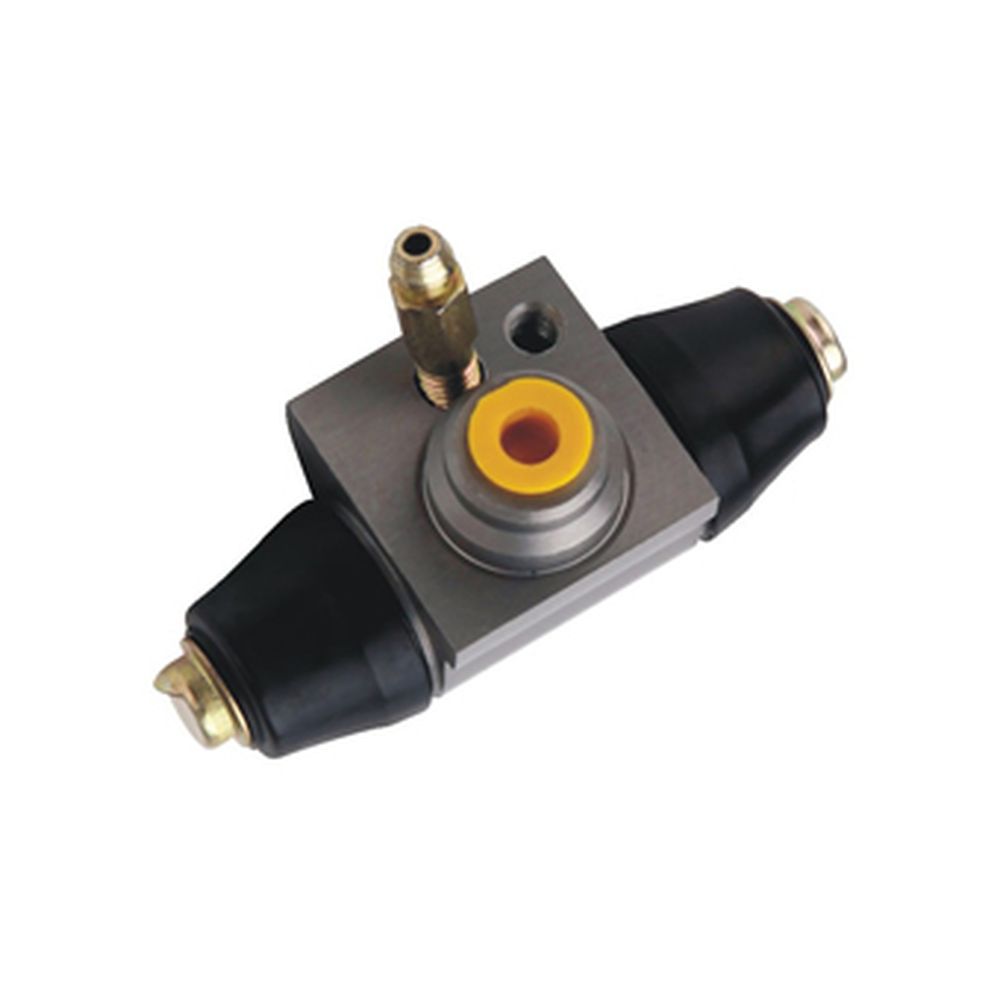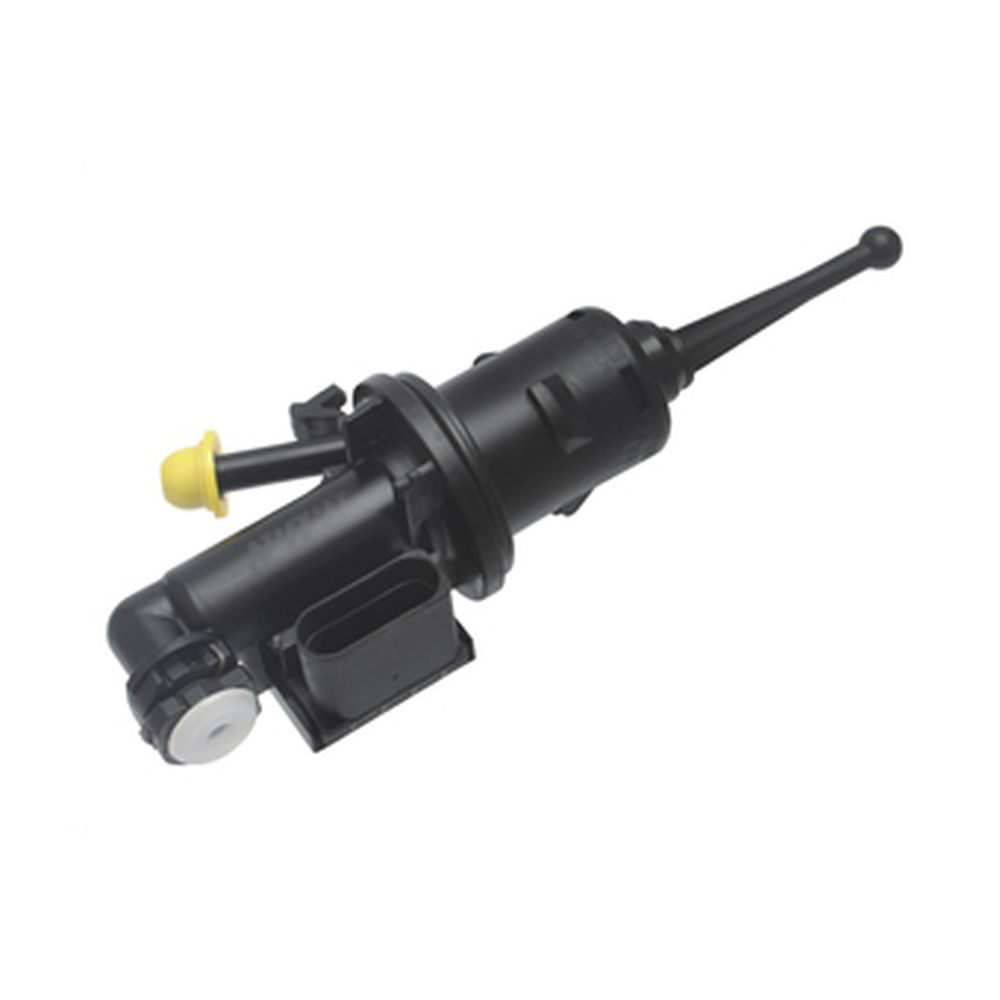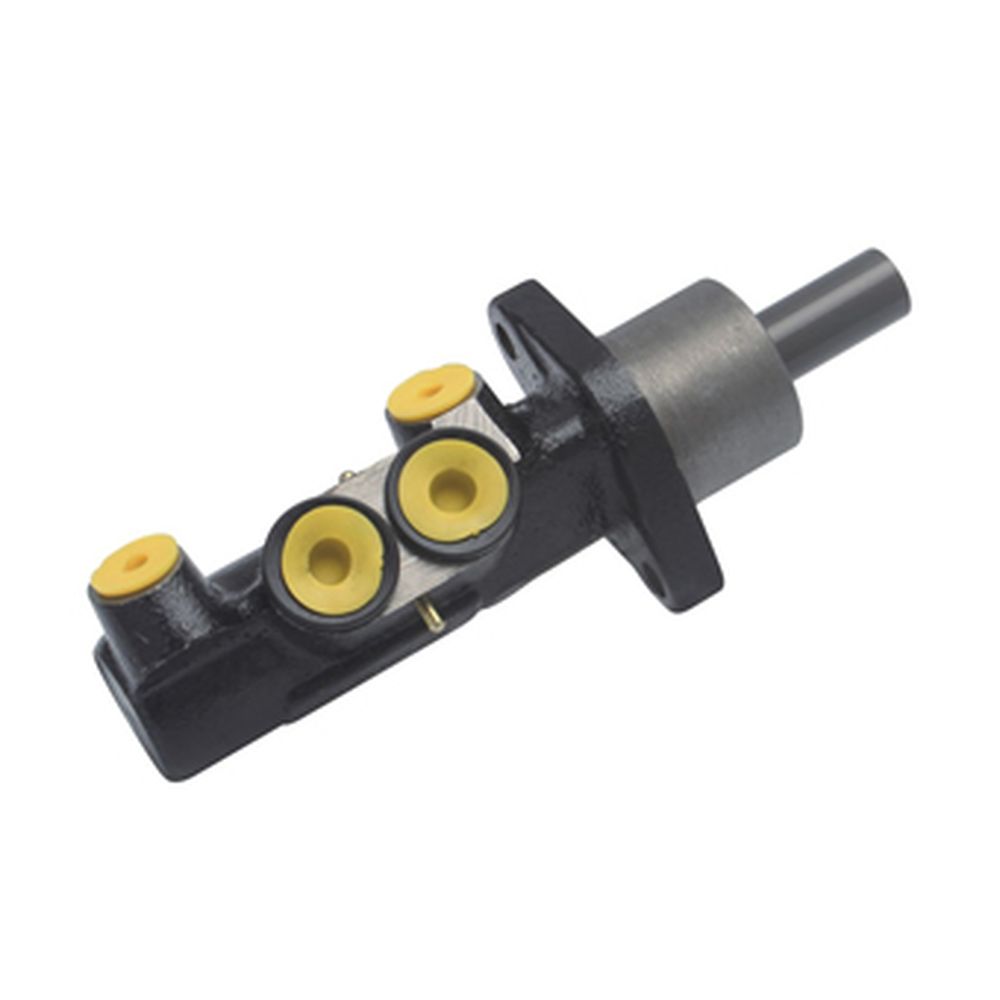A pushrod drives the primary piston to compress the brake fluid in its circuit
As the primary piston moves, hydraulic pressure builds inside the cylinder and brake lines
This pressure drives the secondary piston to compress the brake fluid in its circuit
Brake fluid moves through the brake lines, engaging the braking mechanism
This way, if one brake circuit fails, the other circuit (that controls the other pair) can stop the vehicle.
There’s also a proportioning valve in most vehicles, connecting the master cylinder to the rest of the brake system. It controls the pressure distribution between the front and rear brake for balanced, reliable braking performance.
The master cylinder reservoir is located on top of the master cylinder. It must be adequately filled with brake fluid to prevent air from entering the brake system.
Here’s what happens in the master cylinder when you press down on the brake pedal:
There’s also a proportioning valve in most vehicles, connecting the master cylinder to the rest of the brake system. It controls the pressure distribution between the front and rear brake for balanced, reliable braking performance.
The master cylinder reservoir is located on top of the master cylinder. It must be adequately filled with brake fluid to prevent air from entering the brake system.
Here’s what happens in the master cylinder when you press down on the brake pedal:
The brake master cylinder is the first component in a vehicle’s braking system, activated by depressing the brake pedal. The pedal pushes a piston through this cylinder, forcing brake fluid through brake lines to slave cylinders at each wheel, which in turn drive the pistons that force friction material against the wheel hubs, stopping the wheel. The master cylinder is designed to last the life of the car, but like brake calipers, sometimes it can spring leaks or otherwise fail, and it must be rebuilt or replaced. The master cylinder is topped by the brake-fluid reservoir, which must be kept full.
Most master cylinders have a “tandem” design (sometimes called a dual master cylinder).
In the tandem master cylinder, two master cylinders are combined inside a single housing, sharing a common cylinder bore. This allows the cylinder assembly to control two separate hydraulic circuits.
Each of these circuits controls the brakes for a pair of wheels.
The circuit configuration can be:
Most master cylinders have a “tandem” design (sometimes called a dual master cylinder).
In the tandem master cylinder, two master cylinders are combined inside a single housing, sharing a common cylinder bore. This allows the cylinder assembly to control two separate hydraulic circuits.
Each of these circuits controls the brakes for a pair of wheels.
The circuit configuration can be:
Front/rear (two front and two rear)
Diagonal (left-front/right-rear and right-front/left-rear)
When you release the brake pedal, the springs return each piston to its initial point.
This relieves the pressure in the system and disengages the brakes.
A bad brake master cylinder can result in several issues. Here are some common red flags that indicate a faulty master cylinder:
This relieves the pressure in the system and disengages the brakes.
A bad brake master cylinder can result in several issues. Here are some common red flags that indicate a faulty master cylinder:
1. UNUSUAL BRAKE PEDAL BEHAVIOR
Your brake pedal should reflect any major problems in the sealing or force distribution of your master cylinder.
For example, you might notice a spongy brake pedal — where it’ll lack resistance and may sink slowly to the floor when pressed. The brake pedal may also not spring back smoothly into place after you remove your foot. This is usually due to an issue with your brake fluid pressure – which is likely caused by a bad brake master cylinder.
As a general rule, take your car to the mechanic whenever your brake pedal suddenly starts acting differently.
Your brake pedal should reflect any major problems in the sealing or force distribution of your master cylinder.
For example, you might notice a spongy brake pedal — where it’ll lack resistance and may sink slowly to the floor when pressed. The brake pedal may also not spring back smoothly into place after you remove your foot. This is usually due to an issue with your brake fluid pressure – which is likely caused by a bad brake master cylinder.
As a general rule, take your car to the mechanic whenever your brake pedal suddenly starts acting differently.
2. BRAKE FLUID LEAKS
Brake fluid leaking under your car is a clear sign that something is wrong. If this happens, make it a point to have your mechanic check your brake fluid reservoir. A leak will cause the brake fluid level to drop.
Luckily, the master cylinder has several seals inside it to keep the brake fluid and brake pressure contained. However, if any piston seal wears out, it’ll create internal leaks.
A severe dip in your brake fluid level will compromise the performance of your brake system and your road safety.
Brake fluid leaking under your car is a clear sign that something is wrong. If this happens, make it a point to have your mechanic check your brake fluid reservoir. A leak will cause the brake fluid level to drop.
Luckily, the master cylinder has several seals inside it to keep the brake fluid and brake pressure contained. However, if any piston seal wears out, it’ll create internal leaks.
A severe dip in your brake fluid level will compromise the performance of your brake system and your road safety.
3. CONTAMINATED BRAKE FLUID
Brake fluid is supposed to have a clear, golden yellow to brown color.
If you notice your brake fluid turning a dark brown or black, something’s wrong.
If your brakes aren’t performing up to par, there’s a chance that a rubber seal in the master cylinder has worn out and broken down. This introduces a contaminant into the brake fluid and darkens its color.
4. THE ENGINE LIGHT OR BRAKE WARNING LIGHT COMES ON
Newer vehicles may have brake fluid level and pressure sensors installed in the master cylinder. These will detect unusual drops in hydraulic pressure and alert you.
That’s why, if your engine light or brake warning light turns on, don’t ignore it. It could be a sign of master cylinder failure, especially when accompanied by any of the previous symptoms.
5. WEAVING WHEN BRAKING
The brake master cylinder usually has two separate hydraulic circuits to transfer the brake fluid to two different pairs of wheels. Any failure in one circuit can cause the car to drift to one side when braking.
6. UNEVEN WEAR IN BRAKE PADS
If one of the circuits in the master cylinder has a problem, it can translate to uneven brake pad wear. One set of brake pads will wear down more than the other — which can again result in your car weaving whenever you brake.
Brake fluid is supposed to have a clear, golden yellow to brown color.
If you notice your brake fluid turning a dark brown or black, something’s wrong.
If your brakes aren’t performing up to par, there’s a chance that a rubber seal in the master cylinder has worn out and broken down. This introduces a contaminant into the brake fluid and darkens its color.
4. THE ENGINE LIGHT OR BRAKE WARNING LIGHT COMES ON
Newer vehicles may have brake fluid level and pressure sensors installed in the master cylinder. These will detect unusual drops in hydraulic pressure and alert you.
That’s why, if your engine light or brake warning light turns on, don’t ignore it. It could be a sign of master cylinder failure, especially when accompanied by any of the previous symptoms.
5. WEAVING WHEN BRAKING
The brake master cylinder usually has two separate hydraulic circuits to transfer the brake fluid to two different pairs of wheels. Any failure in one circuit can cause the car to drift to one side when braking.
6. UNEVEN WEAR IN BRAKE PADS
If one of the circuits in the master cylinder has a problem, it can translate to uneven brake pad wear. One set of brake pads will wear down more than the other — which can again result in your car weaving whenever you brake.




